Transactional vs. marketing email (and why it’s important to separate the two)
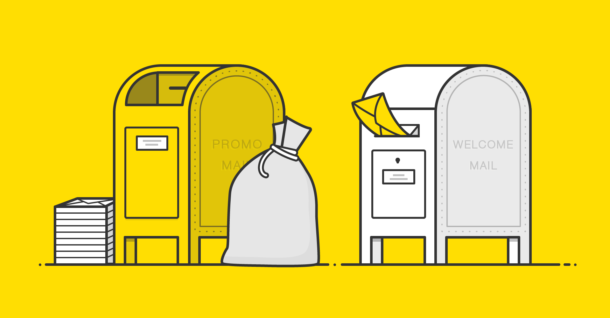
Chances are you’ve heard the advice that you need to “separate your transactional and marketing email.” But what does it mean to separate your emails? Which emails qualify for separation? And what's the difference between transactional and marketing emails anyway?
Let's answer those questions once and for all, so you can check this best practice off your list and focus on your next great idea.
Transactional vs. marketing emails
#
You can lump most email messages into two camps: marketing and transactional, which differ in a few substantial ways—specifically, the trigger behind the email getting delivered in the first place, and the number of people who receive it (one vs. many).
What is a transactional email? #
Transactional emails are emails triggered by an individual customer's action. A welcome email after someone signs up, an alert email a customer has set up in your app, an invoice email, and a comment notification all qualify as transactional emails.
What is a marketing email? #
A marketing email (also called a broadcast, promotional, commercial, or bulk email) is an email that is sent to a list of contacts, with the same content, and is not triggered by an event. A marketing email would be anything a customer did not specifically trigger: for example, a weekly newsletter, a promotional offer, or an announcement about your site's recent updates.
What's the difference between marketing and transactional emails? #
There are some differences to note between these types of email:
- Marketing emails have lower engagement rates. Average open rates for promotional campaigns hover between 10-20%. That’s much lower than the 70% open rates that are typical for password reset emails (a type of transactional email).
- Transactional email delivery speed is measured in seconds. Time to Inbox matters a lot more for transactional emails: when a customer needs to reset their password, a fast delivery is the number one priority.
There's usually a little more leeway with marketing and promotional messages; in fact, sending too many broadcasts too quickly can raise a red flag with email providers. That's why it's important to separate transactional emails from marketing ones, creating a "high priority" lane for your time-sensitive messages. - Marketing emails can be more susceptible to human error. Different email types have unique vulnerabilities: while transactional emails could see bot attacks via spam using online forms, broadcast messages are more likely to involve human errors like sending to the wrong list or mismanaging data. Separating the emails allows you to troubleshoot and resolve issues more quickly.
- Marketing emails require the recipient's permission. Customers have to opt in to receive promotional emails, which also means they can choose to opt out—whereas you need to be able to send critical transactional emails to all customers at any time. Separating these email streams makes managing your subscribers' preferences a lot easier.
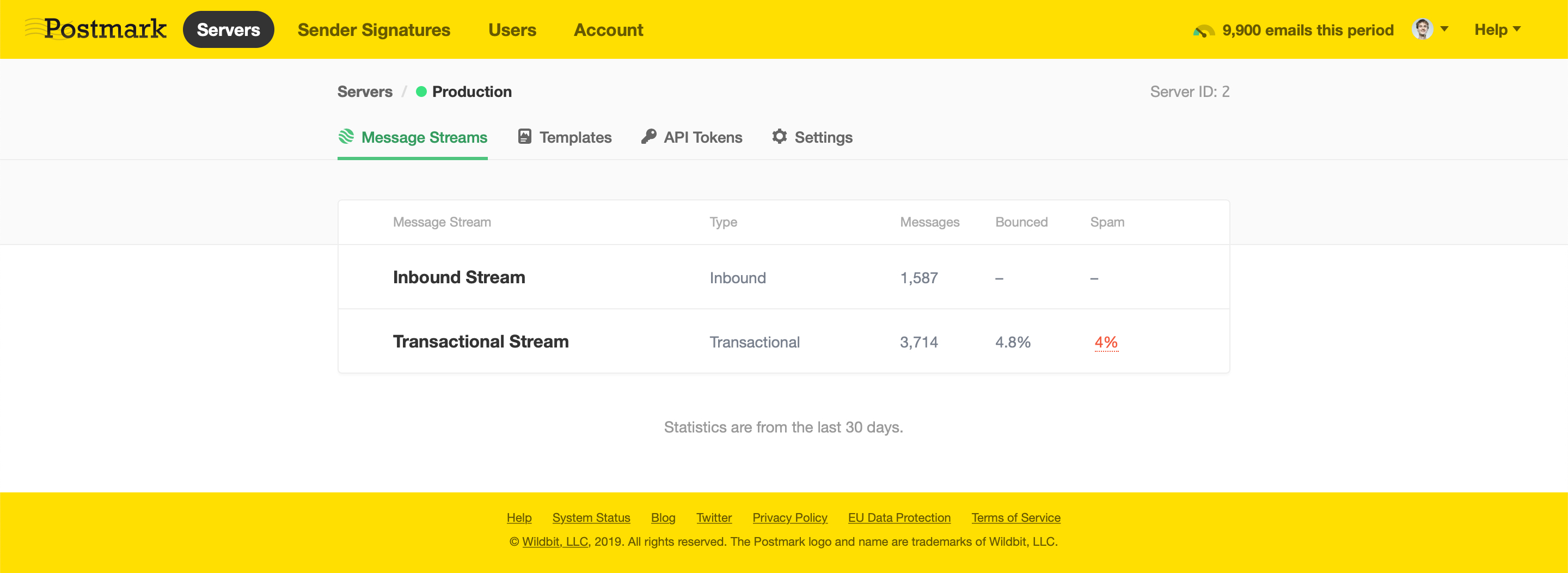
An example of how Postmark (that's us 👋) separates transactional and marketing emails into different message streams.
💡 Pro tip: the reputation of the IP address, domain, and email address all play a role in getting your email into your customer's inbox rather than their spam folder (or, in the case of Google, one of the inbox sub-categories like "Promotional").
Using separate domains or email addresses for each kind of email you send (transactional and promotional) makes it much more likely that your important messages will get to your customers.
Marketing email examples #
Let’s check out a few examples of marketing and promotional emails. The images used for the following examples are all courtesy of Really Good Emails, a great source of inspiration on how to do email messaging the right way!
Discounts #
When you think of a promotional email, discount messages likely come to mind. These are your Black Friday, back-to-school, and buy-more-save-more emails that are very common with e-commerce websites and getting quite popular for services and apps too—like Avocode proves with their back-to-school sale.
Upsells and cross-sells
#
When you’re ready to take things to the next level with a customer, an upsell email comes in to save the day. A usual place for marketing upsell emails is at the end of an onboarding series or when you introduce a new service level.
...and sometimes sending an accompanying email makes more sense than an upsell. Shopify uses the cross-sell email below to offer a solution to a challenge a new user may be facing—and conveniently, it’s for a product they own.
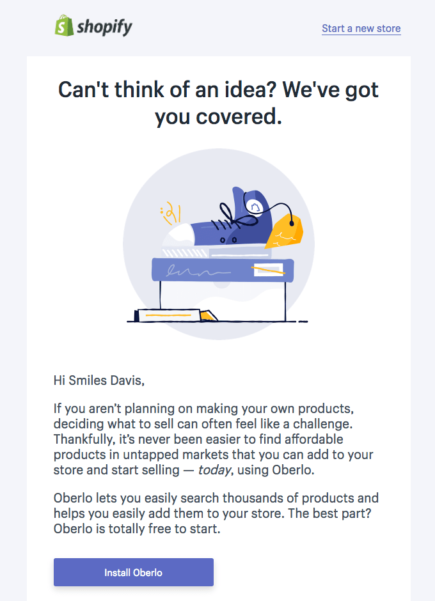
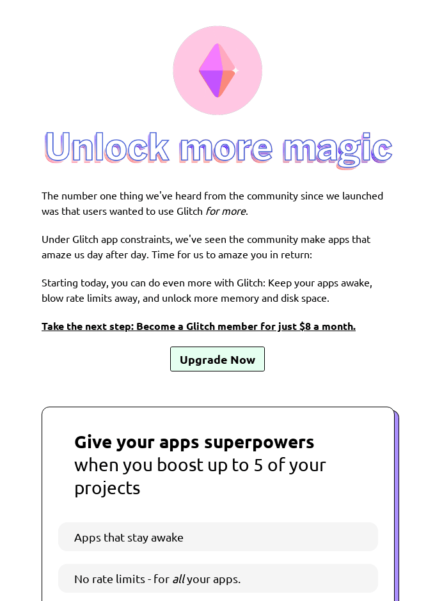
Transactional email examples #
Transactional emails have been Postmark’s bread and butter since day one, and we love to share what we know about getting them right. Below are some of our favorites—but if they're not enough, follow this link to see another eight transactional email examples that we use at Postmark to grow Postmark 😉
Registration and double opt-in #
Transactional emails are often critical, starting with account registration. When someone is creating an account, quickly getting a registration code to their inbox is essential to the user experience. The same is true for a double opt-in message.
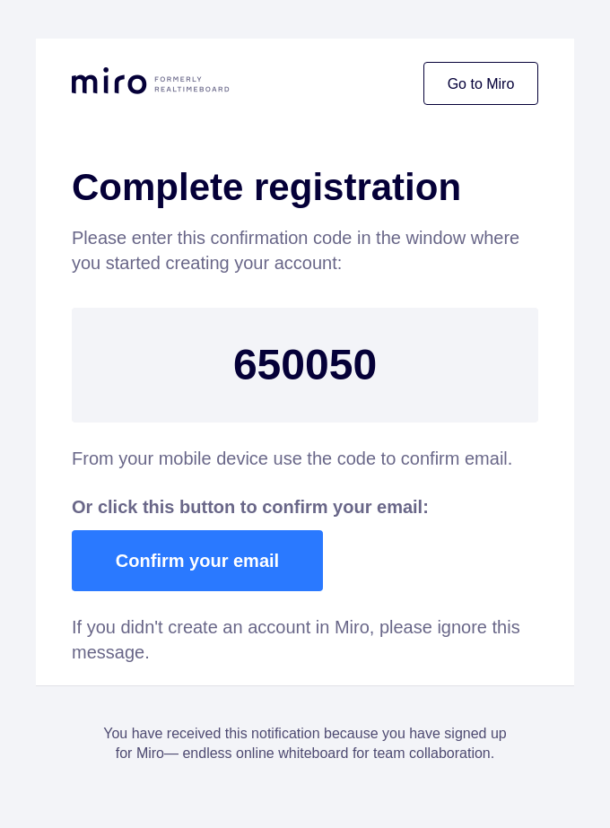
Order confirmations & billing updates #
Sending money to companies over the internet requires trust. A prompt order confirmation email lets customers know their money didn’t disappear into a black hole.
If your company bills on a recurring basis, it’s a good idea to use transactional emails to keep customers updated. Billing update emails could let them know when a payment method has an error, when an account is canceled, or when renewal is coming up.

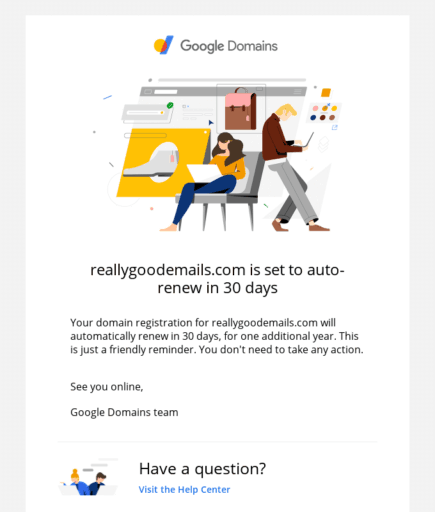
Dunning sequences #
Dunning is the act of emailing customers to notify them that a recurring payment has failed—usually, because of outdated payment information (e.g. card number, expiration date, CVV details), insufficient funds, or a lost, stolen, or otherwise blocked card
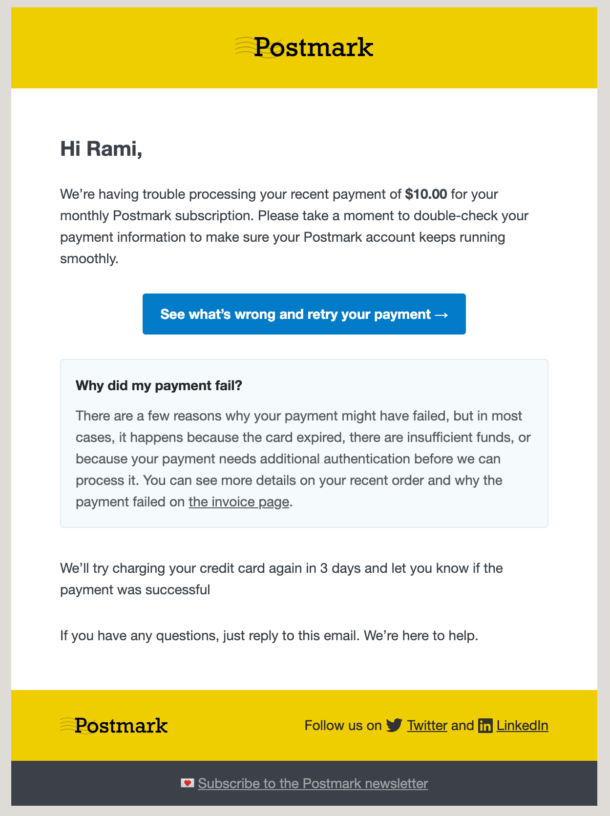
What does it mean to separate marketing and transactional email? #
Gmail officially suggests that "if you send both promotional mail and transactional mail relating to your organization, we recommend separating mail by purpose as much as possible."
But what exactly does that look like?
Separating email types means you make sure your marketing emails come from one source and your transactional from another.
Ideally, you’d have two separate sending infrastructures that include a unique IP address and subdomain. You wouldn’t want to take it as far as two entirely different domains since it could look like a phishing or spoofing attempt.
For example, you can ensure that broadcast and transactional traffic don’t mix by creating a Message Stream for each in Postmark:
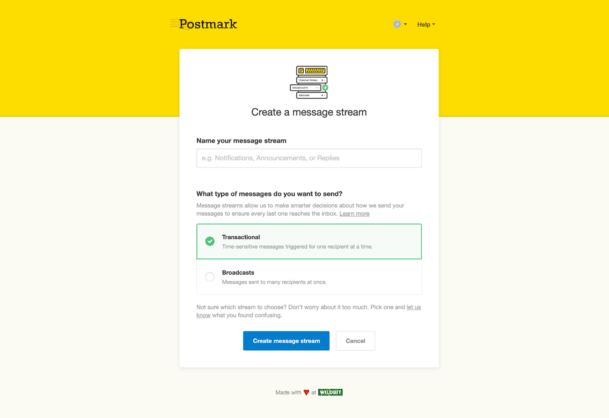
Why you should separate marketing & transactional email sending #
Changing your workflow and sending setup can feel daunting, but here’s what you stand to gain once you invest in separating promotional from transactional messages.
Separating emails = better deliverability #
Deliverability matters.
Especially when you’re dealing with time-sensitive emails like password resets. But promotional messages need to make it to your customer’s inbox, too.
It's not always easy for email providers to categorize messages. By separating transactional and marketing emails, you remove the guessing game and make it easier for inbox providers to sort your emails. If you use the same servers and email address to send both broadcast and transactional email, filtering systems like Gmail's may classify it all as bulk email.
It also means that a sudden drop in your domain reputation from promotional emails won't jeopardize the deliverability of critical transactional messages.
Reduce support requests and improve brand trust #
Lost or delayed transactional emails lead to more "I tried to reset my password, but never got the email" support messages. Each one of those messages means more work for your team and a potentially damaged customer relationship.
By separating promotinoal and transactional emails, you reduce support requests, give back more time to your team, and improve brand trust. It’s a win-win-win.
Managing and troubleshooting are easier
#
Transactional emails need speed, while marketing emails don’t (as much). Marketing emails benefit from routine list maintenance, whereas transactional emails need detailed troubleshooting. These two types of emails have their own goals, best practices, and issues.
By separating the two, you make it easier to optimize each without the other interfering.
How to separate marketing & transactional email sending #
So you’re curious about the details of separating your promotional and transactional emails. Where do you start? There are a few different ways to approach this challenge, with varying degrees of effort and impact.
Good: If you want to take a small step to divide up emails, you could try using different email addresses. For example, marketing emails would come from promo@yourdomain.com and transactional from welcome@yourdomain.com. However, given Gmail’s recommendation to use separate domains and IP addresses, merely using different email addresses should be a last resort.
Better: The next step up in separation would be messaging from different IP addresses. Many email providers let you set up a dedicated IP — usually at an extra cost — that you can use to separate your emails. But be aware that dedicated IPs aren’t a silver bullet for delivery, even though some providers will try to convince you otherwise.
These days, reputation focuses more on domains than IP addresses. This is because it’s much easier for spammers to burn through new IP addresses than to set up new domains.
So while using different IPs for your promotional and transactional email is an important step, you might want to go a step further.
Best: The best choice for fully separating your emails is to use different From addresses, IP addresses, and subdomains. For example, you might send your promotional email from promo.yourdomain.com and your transactional email from notify.yourdomain.com. If you need help warming up that new domain, we’ve got you covered here.

Do you need help separating your marketing and transactional email? #
You're in the right place. If you’re tired of managing two separate email infrastructures, Message Streams can make your life a whole lot easier.
For years, Postmark has been helping customers deliver lightning-fast transactional emails. As products and customer needs evolved, we realized they needed help sending promotional emails with the same reliability.
That’s why we created Message Streams, an easy way to separate transactional from promotional email sends. Thanks to parallel, but separate, sending infrastructures, we can help you get your promotional emails delivered while protecting the fast and reliable delivery of your transactional email.
Here's a video on how Message Streams work in Postmark. This is one you donut want to miss 🍩
If you’re curious about sending promotional and transactional emails with Postmark, check out our Message Streams webinar or take Postmark for a spin with a free trial.



